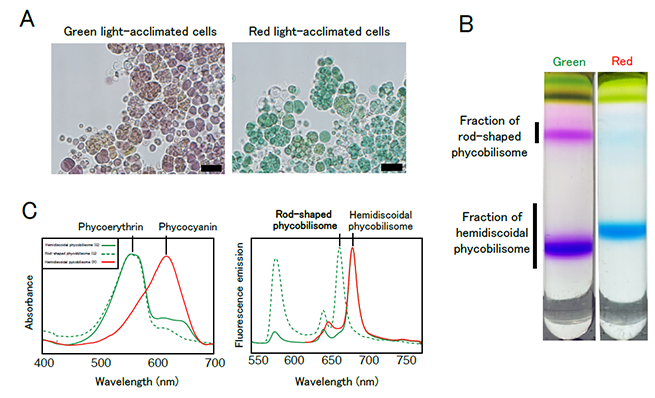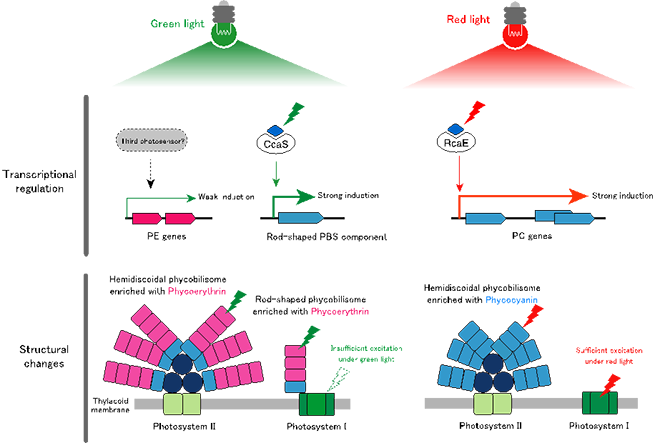
ここからコンテンツです。

Discovery of a cyanobacterium regulating photosynthetic antennas with dual photosensors
A sophisticated mechanism for efficient photosynthesis Yuu Hirose
Cyanobacteria are photosynthetic prokaryotes that regulate the components of light-harvesting protein complexes, phycobilisomes, in response to green and red light. This ability is called chromatic acclimation (CA) and is known to be regulated by a single photosensor that perceives green and red light. A research group led by Yuu Hirose, Associate Professor at the Department of Applied Chemistry and Life Science, Toyohashi University of Technology, discovered a unique cyanobacterium that regulates CA with dual photosensors based on genome information. They investigated the responses of this cyanobacterium to green and red light in detail, and demonstrated that the dual photosensors regulate the morphology and absorption wavelength of the phycobilisomes, respectively. The discovery of the "hybrid type" of CA with dual photosensors provides new insights into how cyanobacteria can flexibly combine multiple photosensors to acclimate to light environments. The results also contribute to the development of the photoswitching system with multiple photosensors in optogenetics.
Cyanobacteria are prokaryotes that perform oxygenic photosynthesis. They are found in almost every environment on earth and have a significant impact on global ecosystems. To survive in these diverse light environments, they have evolved the ability to alter their photosynthetic apparatus. In particular, they have a light-harvesting protein supercomplex called "phycobilisome" that captures the light energy and transfers it to the photosynthetic reaction center complex. Some cyanobacteria can regulate the structure and absorption wavelengths of the phycobilisomes in response to the change of the ambient light colors, which is a process called chromatic acclimation (CA).
Recently, various types of CA responding to different light colors have been discovered. A CA-type responding to green and red light was reported over a century ago. This type of CA is also called complementary CA, as the cell color changes complementary to the color of the illuminated light. This type of CA is regulated by RcaE or CcaS, which are a type of phytochrome-related photosensor protein called cyanobacteriochromes. RcaE and CcaS bind a bilin chromophore and sense green and red light to induce the gene expression of phycobilisome. RcaE induces the phycobilisome components under red light, whereas CcaS induces the different phycobilisome components under green light (the figure below). Cyanobacteria that perform CA using "either" RcaE or CcaS are already known; however, cyanobacteria that have both photoreceptors had not previously been reported (the figure below).

The research group, including master course student Takuto Otsu, Professor Toshihiko Eki, and Associate Professor Yuu Hirose of the Department of Applied Chemistry and Life Science, Toyohashi University of Technology, explored the genome information of cyanobacteria accumulated in the database and discovered that a cyanobacterium Pleurocapsa sp. PCC 7319 has both RcaE and CcaS photosensors (the figure above). The color of green-acclimated cells of strain PCC 7319 became red, whereas that of red-acclimated cells became green. This is the typical response of the CA (A in the figure below). The research group investigated the composition of phycobilisome genes and found that the strain PCC 7319 has genes for phycocyanin and phycoerythrin, which absorbs red and green light, respectively, in the rod part of the phycobilisome. They also found that strain PCC 7319 has genes for two different types of phycobilisomes; hemidiscoidal phycobilisomes and rod-shaped phycobilisomes. They isolated phycobilisomes from the green- and red-light acclimated cells (B in the figure below) and confirmed through absorption and low-temperature fluorescence spectral analyses and LC-MS/MS analysis that the response at the transcriptional level is reflected in the regulation of phycobilisome components (C in the figure below).

B: Photographs of phycobilisome fractions isolated by sucrose density-gradient ultracentrifugation.
C: Absorption and low-temperature fluorescence spectra of the isolated phycobilisome fractions.
The research group revealed by RNA-Seq and promoter motif analyses that CcaS induces rod-shaped phycobilisome gene under green light, and RcaE induces the synthesis of phycocyanin gene clusters under red light (the figure below). These results showed that RcaE optimizes the composition of phycoerythrin and phycocyanin to maximize light absorption under green and red light. On the other hand, CcaS produces the rod-shaped phycobilisome that is predicted to be attached to PSI under green light, where the excitation of photosystem I is insufficient. These findings demonstrated that strain PCC 7319 performs a "hybrid type" of CA which regulates the absorption wavelength and the morphology of the phycobilisomes via dual photosensors. How strain PCC 7319 acquired these dual photosensors has not been revealed in detail; however, it could have acquired such an ability by a mechanism whereby the genes are exchanged between cyanobacteria (horizontal gene transfer). In addition, the RNA-Seq analysis suggested that a third photosensor other than RcaE and CcaS may induce the expression of phycoerythrin genes under green light.

The structural changes in the hemidiscoidal and rod-shaped phycobilisomes will be elucidated using cryo-electron microscopy in future research. In addition, it is also important to identify the third photosensor involved in the induction of phycoerythrin genes under green light. The elucidation of the complex photosensing mechanism in cyanobacteria is expected to have a ripple effect on a wide variety of research, ranging from the understanding of the fundamental mechanisms of photosynthesis to the optogenetic control of living organisms with illumination of colorful light.
This work was supported by MEXT KAKENHI Grant Number 19K06707 "Analysis of diverse structural changes in the phycobilisome during chromatic acclimation (Principal Investigator: Yuu Hirose)." This work was also supported by research grants from JGC-S Scholarship Foundation and the Foundation for the Promotion of Ion Engineering.
Reference
Takuto Otsu, Toshihiko Eki, Yuu Hirose, "A hybrid type of chromatic acclimation regulated by the dual green/red photosensory systems in cyanobacteria," Plant Physiology,
DOI : 10.1093/plphys/kiac284
2つの光スイッチによる「ハイブリッド型」の光合成調節を行うシアノバクテリアを発見
効率よく光合成を行うための巧妙な仕組み広瀬 侑
光合成を行う原核生物であるシアノバクテリアは、周囲の光の色を感知して集光タンパク質複合体であるフィコビリソームの構造や吸収波長を調節します。この能力は光色順化と呼ばれ、赤色光によって活性化する光スイッチタンパク質、若しくは、緑色光によって活性化する光スイッチタンパク質によって制御されることが知られています。豊橋技術科大学応用化学・生命工学系の広瀬侑准教授らの研究グループは、ゲノム情報を手掛かりに2つの光スイッチを併せ持つユニークなシアノバクテリアを発見しました。このシアノバクテリアの緑色光及び赤色光への細胞の応答を詳細に調査し、さらに、フィコビリソームを単離して構成成分の変化を確認しました。これらの結果から、このシアノバクテリアが2つの光スイッチを用いてフィコビリソームの構成成分を制御する「ハイブリッド型」の光色順化を行うことが初めて明らかとなりました。今後は、これらの光スイッチの構造やシグナル伝達経路の解明を進めると共に、光照射による生体活動の光操作への応用も期待できます。
シアノバクテリアとは、酸素発生型の光合成を行う原核生物であり、植物の葉緑体の起源となった生物として知られています。シアノバクテリアは、海洋、湖沼、陸上、極域、温泉、砂漠など、地球上のあらゆる環境に進出し、物質循環や生態系に大きな影響を与えています。シアノバクテリアはこれらの多様な環境下で生存するために、光条件に応じて光合成機能を柔軟に調節する能力を進化させてきました。中でも、光の色を感知する仕組みや、光エネルギーを集める仕組みについては、他の生物種には見られない優れた能力を持つことが、近年の研究によって明らかとなりつつあります。これらのシアノバクテリアの優れた光スイッチを利用して生体活動を光操作する研究や、バイオマス生産の効率を高めるための研究なども進められています。シアノバクテリアは光合成に必要な光エネルギーを集めるために、「フィコビリソーム」と呼ばれる集光タンパク質複合体を持ちます。また、シアノバクテリアの一部は、周囲の光の色を感知してフィコビリソームの形状と吸収波長を調節する能力を持ちます。この能力は「光色順化」と呼ばれ、様々な波長の光に応答するタイプの存在が明らかとなっています。
その中でも、緑色光と赤色光に応答するタイプの光色順化は、100年以上も前に存在が報告されるなど、光合成の環境応答の代表的な例として知られています。近年の研究により、この光色順化が、光スイッチとして機能する光受容タンパク質であるRcaE若しくはCcaSによって制御されることが明らかとなっています。これらの光スイッチは、シアノバクテリオクロムと呼ばれる光受容体の一種であり、ビリン発色団を結合して緑色光と赤色光を感知します。これまでの研究で、RcaEは赤色光に応答し、CcaSは緑色光に応答して、制御下にあるフィコビリソーム遺伝子群の転写を誘導することが知られています。RcaE若しくはCcaSの「どちらか」を用いて光色順化を行うシアノバクテリアは知られていましたが、2つの光受容体を「併せ持つ」シアノバクテリアはこれまで報告例がありませんでした。
豊橋技術科学大学応用化学・生命工学専攻博士前期課程2年の大津卓人氏、浴俊彦教授、広瀬侑准教授らの研究グループは、データベースに蓄積されたシアノバクテリアのゲノム情報を探索し、シアノバクテリア(Pleurocapsa sp. PCC 7319)がRcaEとCcaSの両方の光スイッチを持つことを見いだしました。フィコビリソーム遺伝子の詳細な組成解析を行い、PCC 7319株が、半円状フィコビリソームとロッド状フィコビリソームという異なる形状のフィコビリソームを作るための遺伝子を有していること、また、フィコビリソームの主な色素タンパク質として、赤色光を吸収するフィコシアニンと、緑色光を吸収するフィコエリスリンを持つことを明らかにしました。次世代DNAシークエンサーを用いたRNA-Seq解析により、CcaSが緑色光下でロッド状フィコビリソームの遺伝子群を誘導し、RcaEが赤色光下でフィコシアニン遺伝子群の合成を誘導することを明らかにしました。実際に、細胞からフィコビリソームを抽出して単離し、吸収スペクトル及び低温蛍光スペクトル解析とLC-MS/MS解析によって、転写レベルの応答がフィコビリソームの構成成分の調節に反映されていることを確認しました。
これらの結果から、RcaEは緑色光及び赤色光下での光の吸収効率が最大となるように、フィコエリスリンとフィコシアニンの比率を調節していることがわかりました。一方で、CcaSは緑色光下でロッド状フィコビリソームを合成することで、緑色光条件で不足する光化学系Iの励起バランスを補っていることがわかりました。つまり、PCC 7319株はフィコビリソームの吸収波長と形状を2つの光スイッチを用いて制御する「ハイブリッド型」の光色順化を行っていることが初めて明らかとなりました。PCC 7319株がこれらの2つの光スイッチをどのように獲得したのか、その詳細は明らかでありませんが、シアノバクテリア同士で遺伝子を交換する仕組み(遺伝子水平伝播)によってこのような能力を獲得した可能性が考えられました。また、今回、RcaEとCcaS以外の第3の光スイッチが存在し、フィコエリスリン遺伝子群の発現を緑色光下で誘導する可能性が示唆されました。
今後は、今回の研究によって明らかにしたフィコビリソームの構造変化をクライオ電子顕微鏡等の手法を用いて分子レベルの分解能で解明することが必要です。また、緑色光下でフィコエリスリン遺伝子群の発現誘導に関わる第3の光スイッチの同定も重要です。シアノバクテリアは地球上の生物の中で最も優れた光応答能を持つ生物の1つであり、それを可能とする分子メカニズムを解明できれば、光合成の基本機能や環境応答を理解する基礎研究から、光照射によって生物機能を操作する応用研究まで、幅広い研究に波及効果を与えることが期待できます。
本研究は、文部科学省科研費基盤研究(C)19K06707「補色順化におけるフィコビリソームの構造変化の多様性の解明(代表者:広瀬侑)」、公益財団法人日揮・実吉奨学会、一般財団法人イオン工学振興財団の研究助成による支援を受けて行われました。
Researcher Profile

| Name | Yuu Hirose |
|---|---|
| Affiliation | Department of Applied Chemistry and Life Science |
| Title | Associate Professor |
| Fields of Research | Photobiology / Genome Biology |
ここでコンテンツ終わりです。
